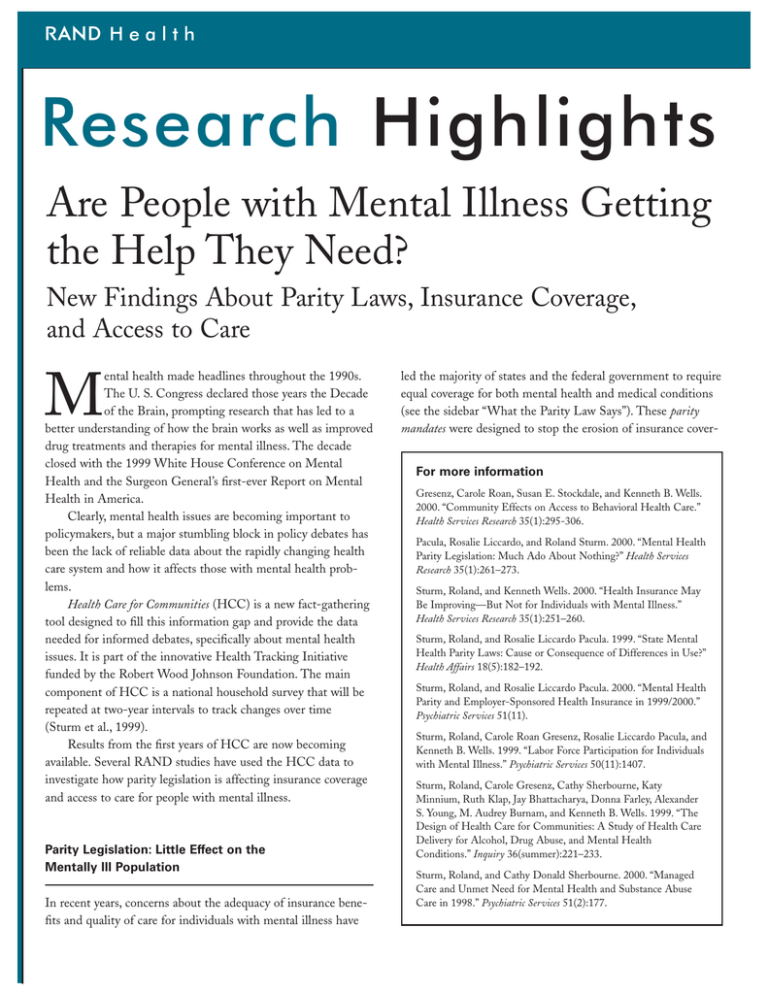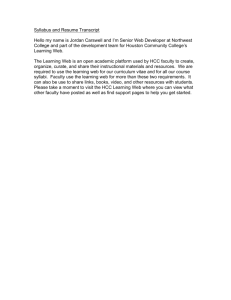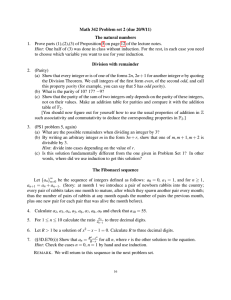Research Highlights M Are People with Mental Illness Getting
advertisement

RHealth Research Highlights Are People with Mental Illness Getting the Help They Need? New Findings About Parity Laws, Insurance Coverage, and Access to Care ental health made headlines throughout the 1990s. The U. S. Congress declared those years the Decade of the Brain, prompting research that has led to a better understanding of how the brain works as well as improved drug treatments and therapies for mental illness. The decade closed with the 1999 White House Conference on Mental Health and the Surgeon General’s first-ever Report on Mental Health in America. Clearly, mental health issues are becoming important to policymakers, but a major stumbling block in policy debates has been the lack of reliable data about the rapidly changing health care system and how it affects those with mental health problems. Health Care for Communities (HCC) is a new fact-gathering tool designed to fill this information gap and provide the data needed for informed debates, specifically about mental health issues. It is part of the innovative Health Tracking Initiative funded by the Robert Wood Johnson Foundation. The main component of HCC is a national household survey that will be repeated at two-year intervals to track changes over time (Sturm et al., 1999). Results from the first years of HCC are now becoming available. Several RAND studies have used the HCC data to investigate how parity legislation is affecting insurance coverage and access to care for people with mental illness. M Parity Legislation: Little Effect on the Mentally Ill Population In recent years, concerns about the adequacy of insurance benefits and quality of care for individuals with mental illness have led the majority of states and the federal government to require equal coverage for both mental health and medical conditions (see the sidebar “What the Parity Law Says”). These parity mandates were designed to stop the erosion of insurance coverFor more information Gresenz, Carole Roan, Susan E. Stockdale, and Kenneth B. Wells. 2000. “Community Effects on Access to Behavioral Health Care.” Health Services Research 35(1):295-306. Pacula, Rosalie Liccardo, and Roland Sturm. 2000. “Mental Health Parity Legislation: Much Ado About Nothing?” Health Services Research 35(1):261–273. Sturm, Roland, and Kenneth Wells. 2000. “Health Insurance May Be Improving—But Not for Individuals with Mental Illness.” Health Services Research 35(1):251–260. Sturm, Roland, and Rosalie Liccardo Pacula. 1999. “State Mental Health Parity Laws: Cause or Consequence of Differences in Use?” Health Affairs 18(5):182–192. Sturm, Roland, and Rosalie Liccardo Pacula. 2000. “Mental Health Parity and Employer-Sponsored Health Insurance in 1999/2000.” Psychiatric Services 51(11). Sturm, Roland, Carole Roan Gresenz, Rosalie Liccardo Pacula, and Kenneth B. Wells. 1999. “Labor Force Participation for Individuals with Mental Illness.” Psychiatric Services 50(11):1407. Sturm, Roland, Carole Gresenz, Cathy Sherbourne, Katy Minnium, Ruth Klap, Jay Bhattacharya, Donna Farley, Alexander S. Young, M. Audrey Burnam, and Kenneth B. Wells. 1999. “The Design of Health Care for Communities: A Study of Health Care Delivery for Alcohol, Drug Abuse, and Mental Health Conditions.” Inquiry 36(summer):221–233. Sturm, Roland, and Cathy Donald Sherbourne. 2000. “Managed Care and Unmet Need for Mental Health and Substance Abuse Care in 1998.” Psychiatric Services 51(2):177. RHealth age for mental health care at a time when scientific research is yielding significant advances in treating mental illness, and to make it easier for the country’s mentally ill population to get help. However, the HCC data suggest that these goals are not being met. effect of deteriorating insurance coverage appears to be somewhat unique to mental health care.” Loss of insurance usually results from loss of employment, which often provides private insurance. An analysis of HCC employment data showed that despite the economic vitality of the 1990s, the unemployment rate for the mentally ill population was three to five times higher than for the rest of the population (Sturm et al., 1999). Moreover, people at risk for mental health problems were significantly more likely than the remainder of the population to have left a job that provided insurance (see Figure 1). “Compared with the general population, individuals with mental health problems experienced a deterioration in their health insurance status.” Figure 1. Unemployment and Mental Illness 12 10 Insurance Coverage During the 1996 to 1998 timeframe of the HCC survey, the percentage of uninsured individuals in the general population did not increase significantly. People without mental disorders reported stable insurance and improved benefits. In contrast, however, persons with mental disorders said that the quality of their insurance coverage and their access to care declined during those years. These people were also significantly more likely to have lost their health insurance (Sturm and Wells, 2000). “The insurance findings are unambiguous: Compared with the general population, individuals with mental health problems experienced a deterioration in their health insurance status,” concluded the researchers. “There is no consistent similar effect among people with chronic medical conditions, so the Previously employed, now out of labor force Previously employed, now unemployed 8 % 6 4 2 0 No mental health disorder Any mental health disorder Depression Bipolar/ psychotic Individuals at risk of mental health disorders are significantly more likely than the rest of the population to leave a job that provided insurance, risking disruption of care. This figure illustrates the probability that previously employed, insured individuals with or without mental health disorders would become unemployed or leave the labor force during the 1996–1998 timeframe of the HCC survey (Sturm et al., 1999). What the Parity Law Says The federal Mental Health Parity Act is limited in scope. It does not compel employers to offer mental health coverage; it only requires that the dollar limits on such coverage be equal to dollar limits on medical benefits if mental health coverage is offered. In addition, the Parity Act does not impose any conditions on deductibles, copayments, limits on days of hospitalization or office visits, or require coverage for substance abuse. Thus, it gives employers and insurers many options for responding to the law, including dropping mental health benefits completely. In addition, the law exempts a plan if application would increase total medical costs for the plan by 1 percent or more. It also exempts small employers (those with 50 or fewer employees). State parity laws are often much stronger than the federal legislation but do not apply to self-insured employers. Utilization of Services State parity laws have had no significant effect on utilization of mental health services. Utilization is no higher in parity states than in states without such laws (see Table 1). One explanation is that despite numerous laws there have been virtually no changes in employer-sponsored benefits (Sturm and Pacula, 2000). Another explanation is that parity laws lead health plans to use managed care more intensively, leaving persons most in need concerned about adequate coverage and about the quality of their care. Politics and Parity The passage of parity legislation is the result of a political process that pits proponents (generally patient advocacy groups 2 RHealth mental health care, compared with those who have less severe mental health problems. Table 1. States with Parity Laws Lag Behind Nonparity States in Use of Mental Health Services States without States with parity laws parity laws Percentage who have private insurance 65% 64% Percentage who have used any mental health services 7% 6% Percentage who have used mental health specialty care 6% 4% Number of mental health specialty visits in past year 13 12 74% 67% Percentage of specialty visits insured Privately insured HCC respondents only States without States with parity laws parity laws Percentage who used any mental health services 7% 5% Percentage who used mental health specialty care 6% 4% Number of mental health specialty visits in past year 13 11 72% 66% Percentage of specialty visits insured Less Access to Comprehensive Care An analysis of the self-reported unmet need among HCC respondents seeking treatment for emotional, mental health, alcohol, or drug problems supports this view. When unmet need is defined as delays in receiving treatment or receiving less treatment than desired, persons in managed care had unmet needs more often than those in unmanaged care. In contrast, when unmet need is defined as no care, those in managed care had unmet needs less often (see Figure 2). Although managed care may make it easier to access some treatment, it may make it harder to get comprehensive care (Sturm and Sherbourne 2000). Figure 2. Managed Care and Levels of Care Received % of individuals with self-reported unmet need All HCC respondents (Adapted from Sturm and Pacula, 1999.) and provider organizations) against opponents (generally employer and insurance associations). What influences which side wins? An analysis of HCC data on mental health services utilization in states before and after they passed parity legislation turned up an unexpected answer: Those states with fewer people using mental health care services to begin with were more likely to pass parity laws. Apparently, having fewer affected people within the population helped reduce opposition to parity legislation, which opponents argue would lead to increased use of services and consequently increased costs (Sturm and Pacula, 1999; Pacula and Sturm, 2000). 25 Less/ delayed care 20 15 10 No care 5 0 Unmanaged Weak Strong care managed managed care care Traditional HMO insurance Privately insured people with mental illness report receiving different levels of care depending on how strongly the care is managed by their insurance plans. HCC data show that for persons in managed care the odds of receiving no care for mental health problems are lower than for those in unmanaged care. But the odds of receiving less care than desired, or delayed care, are higher for those in strongly managed care (Sturm and Sherbourne, 2000). Local Factors Affect Access Recognizing the potentially strong influence of local factors, a related study examined how managed care and other variables (urbanization, provider availability, and poverty) affected access to behavioral health care at the community level (Gresenz, Stockdale, and Wells, 2000). Communities with a higher percentage of managed care providers have better overall access to health care, which in Insurance Market Response to Parity: More Managed Care The insurance market responds to the passage of parity laws by increasing the management of care in order to control costs. This shift toward more managed care may be one reason why people with more severe mental health problems report that it is becoming increasingly difficult for them to obtain good 3 RHealth turn improves access to some behavioral health care. This increased access may stem from spillover effects—for example, changing help-seeking patterns in the community, increased advertising and education, and cost reduction through increased competition among providers. Although managed care may improve overall access to behavioral health care, community income appears to be a factor in the type of care received. People living in poorer communities—whether or not they are poor themselves—typically receive behavioral health care from primary care physicians and are less likely to receive care from specialists. Decreased access to specialists may be due to limited availability of specialists or to primary care physicians being less likely to refer patients to specialists. Conclusion These initial evaluations of HCC data reinforce concerns about health care quality expressed in the Surgeon General’s report on mental health: Despite parity legislation, insurance coverage remains problematic for persons at risk for mental disorders. Parity mandates have not resulted in either increased use of mental health services or higher insurance costs, as opponents had feared. Many factors, including public policy and market trends at the national, state, and local levels, affect health insurance coverage and the availability and use of health care services. Such factors must be addressed in any effort to reduce or eliminate the disparity in health care experienced by the mentally ill. Abstracts of all RAND Health publications may be viewed on the World Wide Web (http://www.rand.org/organization/health). RAND is a nonprofit institution that helps improve policy and decisionmaking through research and analysis. RAND Health furthers this mission by working to improve health care systems and advance understanding of how the organization and financing of care affect costs, quality, and access. RAND® is a registered trademark. R 1700 Main Street, P.O. Box 2138, Santa Monica, California 90407-2138 • Telephone 310/393-0411 • Fax 310/393-4818 1200 South Hayes Street, Arlington, Virginia 22202-5050 • Telephone 703/413-1100 • Fax 703/413-8111 RB-4533 (2000)






